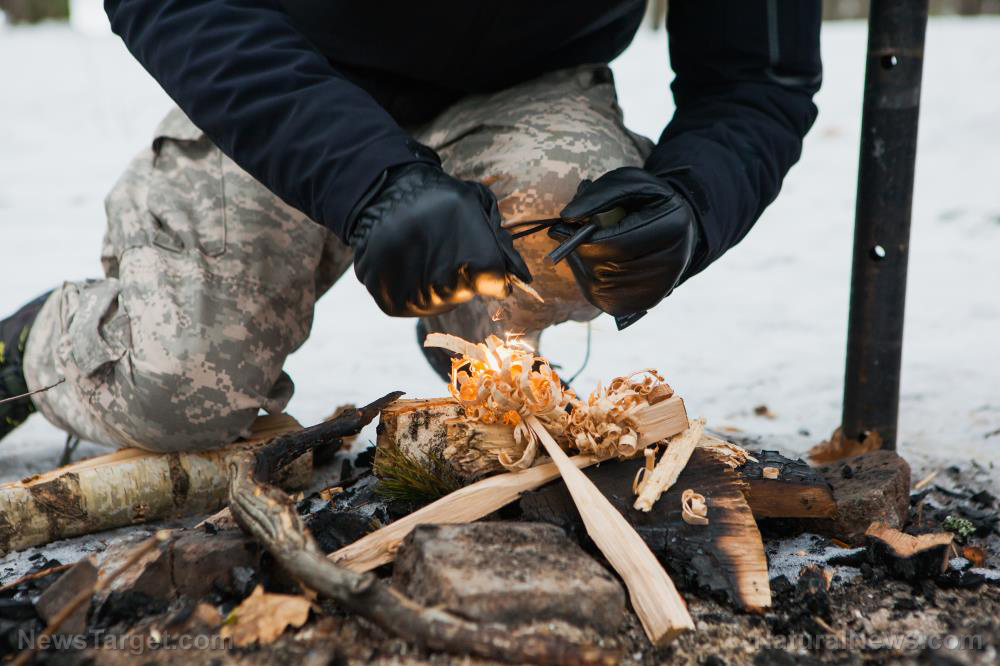
Below are some essential survival skills that modern preppers should learn and practice so they can survive if they lose their gear or bug-out bag when disaster strikes. (h/t to AskAPrepper.com)
How to start a fire without matches
You need a campfire to stay warm, cook and boil water when SHTF. Knowing how to start a fire, even without matches, is crucial to survival.
You can start a fire with different methods, but the best and most effective is the bow drill method.
You will need:
- A flat piece of wood
- A spindle or a straight stick
- Another thin stick for the bow
- Some string (e.g., shoelace or paracord)
- Tinder (e.g., dry leaves, pine needles, shaved bark, etc.)
Steps:
- Cut the spindle to about 12 inches (30 cm). Sharpen one end.
- Cut a V-shaped notch on a flat piece of wood and place the tinder underneath it.
- Tie the thin stick to the spindle at one end, then loop the string around it.
- Place the spindle into the notch in the wood, then start rotating the spindle by pressing down on it. Use the bow stick to turn the spindle.
- Once you’ve generated a bit of friction and heat, you’ll see a bit of smoke. Add more fuel so that the smoke catches fire. Keep going until it is burning steadily.
How to build basic shelters with natural materials
Having a bug-out bag is crucial for your survival, but what if you lose your gear after a disaster?
While preparing for various scenarios, take the time to learn how to build basic shelters using materials you can find. You need shelter, even a temporary one, for protection when it is hot outdoors.
The most basic shelter is a debris hut, which you can build from sturdy sticks and leaves. A debris hut can be built within one to three hours. It will do for short-term protection.
Steps:
- Find an area that is well-drained and sheltered from the wind.
- Use an eight-foot stick and poke it into the ground at a 45-degree angle. Stack other sticks against the first stick to form a triangle.
- Cover the arranged sticks with at least four inches of debris to form a waterproof layer.
- Make sure the bottom of the shelter is dug out slightly so rainwater can drain away.
- Position the entrance facing away from the wind for extra protection.
- When lighting a fire, place it near the entrance so you can keep warm and cook food.
- Line the inside of your shelter with soft materials, like grass, for padding.
How to identify edible herbs and plants
If you are facing a survival scenario and are running out of food and supplies, knowing how to forage for edible herbs and wild plants may save your life. Before SHTF, sign up for classes or self-study to learn how to distinguish between edible plants and their poisonous look-alikes.
You can also read up on a universal plant edibility test to learn how to identify edible plants correctly. Keep in mind that this test does not work for wild mushrooms, so avoid those when using this test.
To do the universal plant edibility test:
- Look for common poisonous traits like fine hairs, spikes, waxy leaves and milky or discolored sap.
- Separate the plant into its different parts: fruits, flowers, leaves, stems and roots.
- Smell each part separately and check for a strong or unpleasant odor.
- Place a small part of the plant on your skin, like your elbow or outer lip, then wait 15 minutes. Look for any irritation or allergic reaction.
- Taste each part of the plant separately. Spit out any parts that have a strong taste or bitter aftertaste.
- Chew the plant, then wait another 15 minutes to see any reaction. If you are fine, swallow the plant and wait at least eight hours for any adverse reactions. This is the only way to confirm if a plant is safe to eat.
How to look for water sources
When disaster strikes, you might get stranded in the wilderness and lose your gear. You can’t survive more than a few days without a water source, so you need to learn how to find and purify water.
Keep these tips in mind to learn how to spot water sources:
Puddles and other water-filled depressions in the ground
You may find puddles in low-lying areas and they can be filled with rain or groundwater seeping up from the earth’s surface.
Snow and ice
If it’s cold enough, you can melt snow or scrape the top layer of ice from a lake or river for fresh drinking water. Don't consume untreated snow or ice because this will drop your core temperature.
Dew on plants
If the timing is right, you can collect the morning dew on plants.
Rainwater
Set up a tarp to capture and funnel rainwater into a container like a bottle during the rainy season. Purify the water you harvest before drinking it.
Animal tracks
If you spot animal tracks in the wilderness, you may find water sources.
Once you find a water source, purify the water by filtering it or by boiling it. Bring the water to a rolling boil for at least one minute to eliminate bacteria and other contaminants.
How to catch small prey with traps
Once you build a fire, set up a shelter and find some water, set a trap to catch small prey.
Setting a trap is one of the most common and effective ways to catch small prey, and making a snare is one of the simplest ways to do this.
You will need:
- Wire
- Wire cutters
- A trigger mechanism, like a bent stick
- An anchor point, like a log or tree
Steps:
- Cut the wire into three pieces of equal length. The wire pieces must be long enough to form a noose around the animal when set in place.
- Create a loop with one piece of wire. Grasp each end in one hand and twist it together to form a lasso.
- Attach the looped wire to a trigger mechanism, like a bent stick or spring-loaded holder. The trigger system should be secure enough to hold the wire once it is set up.
- Securely attach the other two pieces of wire to an anchor point, like a log or tree, at eye level from where you plan on setting the trap. The wires must be securely tied or fixed so the animal won't be able to escape.
- Place the noose over an area where you think animals may pass through, then carefully set up the trigger system so that when an animal walks by, it will trip and release the noose around its body, effectively trapping it in place. (Related: 20 Wilderness survival tips that might save your life after SHTF.)
How to deal with wildlife
Wild animals are common in rural areas and some of them may be dangerous and even deadly. Learn how to deal with wildlife to avoid accidents during a survival scenario.
Follow the tips below to learn how to deal with wild animals:
- If you encounter wild animals, avoid sudden movements. This can frighten them and make them attack.
- If you encounter a predator like a bear or a mountain lion, stand your ground. Lift your arms and stand tall to make yourself look as large as possible.
- Don't wander off a hiking trail after dark.
- Don't surprise a mother with her babies. Even a gentle-looking deer may attack to protect its young.
- Make noise to let animals know you’re nearby so you don’t startle them.
- Keep an eye out for animal tracks and poop. These signs can let you know what might be around.
- Always carry bear spray if you’re in an area known to have bears.
- Don’t try to run away. Don't make direct eye contact for this could trigger an attack.
- Don't make the animal feel trapped. If an animal like a bear feels cornered, it could become aggressive.
First aid for SHTF emergencies
Knowing first aid is also crucial to your survival when disaster strikes. Even if you don't get hurt, you can use your first aid skills to help a family member who gets injured or wounded after SHTF.
Knowing how to treat minor injuries and life-threatening ones can save someone's life.
Here are some essential first-aid tips that might help:
Sprains and strains
Tear off a piece of cloth, wrap it around the injured area and tie it securely. This will provide some support to the injured arm or ankle.
Bleeding
Apply direct pressure to the wound with a clean cloth. Apply pressure until the bleeding stops.
Hold the wound above the heart level if possible.
Burns
Flush the affected area with cool water for 20 minutes. This will reduce the pain and help prevent further damage to the patient's skin.
Fractures
Splint the affected area with tree branches and make sure the fractured limb is positioned comfortably.
Apply firm pressure on the splinted area to prevent the injured body part from moving.
Hypothermia
If you or someone else suffers from hypothermia, carefully move them to a warm and sheltered area.
Cover them with a blanket or extra clothes. Give them warm drinks and food to help their body temperature return to normal.
These essential survival skills can help you stay alive when SHTF even after you lose your gear and bug-out bag.
Watch the video below for tips on how to start a fire using a flint rod.
This video is from the Connor Lindeman channel on Brighteon.com.
More related stories:
Survival skills: Learn how to cook from scratch so you can feed your family when SHTF.
What are skills, rules and principles that will help you survive the wilderness alone?
Wilderness survival: What to do if you get bitten by a snake.
Sources include:
Please contact us for more information.























